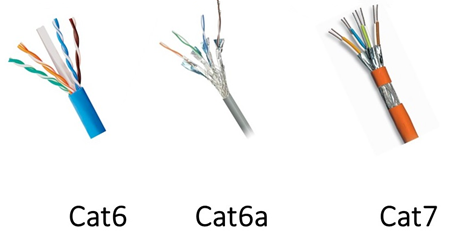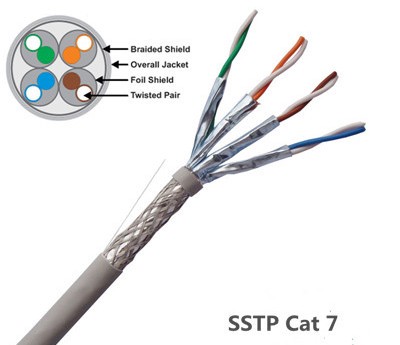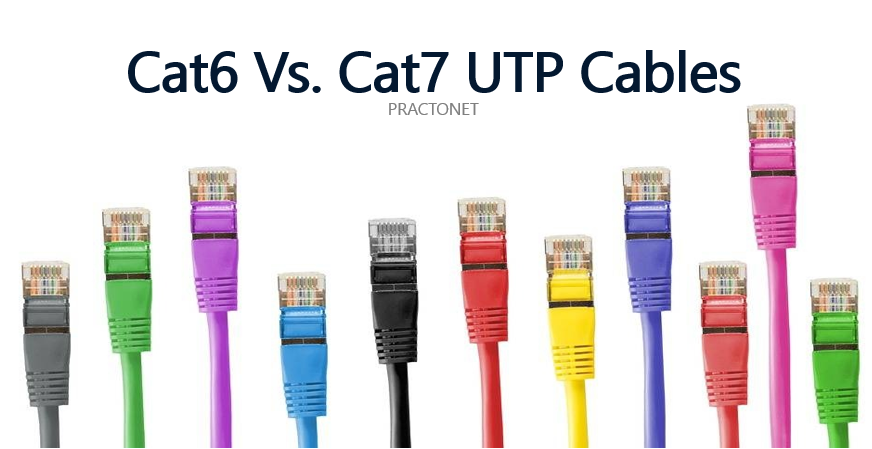The demands for high bandwidth keep increasing as the video and multimedia gain a large popularity among end users. The data rate of 1Gbps is gradually growing to 10Gbps. The Cat5e patch cables used to support 1Gbps network are no longer enough for 10Gbps, which calls for new specifications of twisted pair copper cabling. Ethernet cable with higher bandwidth such as Cat6 cable, Cat6a cable and Cat7 cables are introduced for high-speed applications of 10GBASE-T.
Cat6 (Class E), Cat6a (Class EA) and Cat7 (Class F) are improved twisted pair specifications that can support 10GBASE-T applications. Each cable is backward compatible, meaning you can plug a newer twisted pair cable into a device that is created for a slower cable. Cat6 can be used for 10Mbps, 100Mbps, 1000Mbps and 10Gbps. But Cat6 can support 10GBASE-T for only up to 55 meters (depending on crosstalk) and frequencies of up to 250 MHz. Cat6a (Cat6 augmented) is designed to support frequencies of up to 500 MHz, which is twice that of Cat6. And Cat6a can support up to 100 meters when transmitting 10Gbps. Cat6a cable can be divided into shielded and unshielded type respectively referred to as F/UTP (shielded) and U/UTP (unshielded) cable. Cat6a F/UTP is easier to handle than Cat6a U/UTP. Cat7 cabling can also support 10GBASE-T but is rated for transmitting frequencies of up to 600 MHz.

Cat6 vs Cat6a
Cat6a 10GBASE-T cable using RJ45 connectors can deliver 10G performance of higher frequencies (500 MHz) and with longer link lengths (100 m) than that of Cat6 cable (250 MHz, 55 m). Compared with Cat6, Ca6a has more robust sheathing, which reduces alien crosstalk and improves signal-to-noise ratio.
While Cat6 10GBASE-T cable can support 10GBASE-T over the distance between 37 and 55 meters depending on the alien crosstalk environment, there is no 10GBASE-T application support assurance over short runs of Cat6, because alien crosstalk is highly dependent on cable density. And the cable quality from different manufacturers can’t be guaranteed. Only when you test it will you know if the Cat6 cable meets the specification. Besides, adopting Cat6 cable in 10Gbps can’t make use of power-saving short-reach mode. Short reach mode can reduce power consumption by 1W per port when using Cat6 of 30 meters or less. So 10GBASE-T cable Cat6 is not cost-effective and environment-friendly for 10GBASE-T application. What’s more, Cat6 cable can’t dissipate heat as well as Cat6a 10GBASE-T cable since Cat6 10GBASE-T cable has smaller diameter conductor. Data center temperatures are increasing. At the same time, cable insertion loss also increases. This is not good for network performance.
Cat6a vs Cat7
Actually, Cat7 standard was ratified to support 10Gbps over 100 m earlier than Cat6a. A major advantage of Cat7 cable is that it has the shield for each of the four wire pairs and for the four pairs as a whole. For this reason, Cat7 cable has greater noise resistance. But conversely, the shielding makes Cat7 less flexible and manageable. The key concerns are the wire pairs must be fully surrounded by the shield in the cable from end to end, and must provide proper grounding.
Cat7 bandwidth is higher than Cat6 bandwidth. Also, the connector type for Cat7 has a small difference. Its worldwide standard is using RJ45 compatible GG45 connector. Though Cat7 can also use RJ45 connector, it will be less easy to terminate this cable with thick sheathing to the narrow jack in the field. You may need to hire a specialized electrician or spend a long time to terminate the RJ45 jacks to Cat7 cables on your own.

Cat7 cable speed has shown the potential to reach the data rates of 40Gbps, 50Gbps and 100Gbps. But the Cat7 cable itself only provides the power and speeds of the equipment and Internet-type it is working with. The Internet speed will not be improved when you only change to a faster cable but remain using slower speed equipment.





